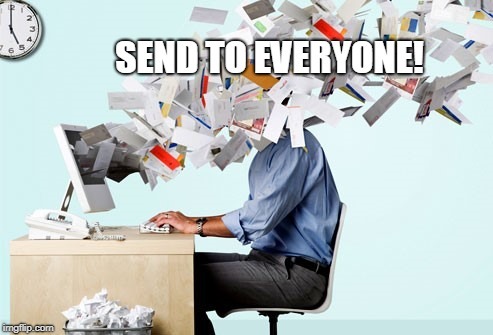Email marketing has been around for what seems like forever. By the look of things, it is not going anywhere anytime soon. And, this is despite the prevalence of social media marketing. Why is this the case, you ask?
Because email marketing has been, and still is, an effective marketing tool. However, making some obvious mistakes can diminish the effectiveness of your email marketing campaigns. Here are ten such mistakes that you should avoid.
1. Using Your Personal Email Account
Cash-strapped and inexperienced first-timers often make this mistake. Since they cannot afford an email marketing provider, they consider it a good idea to use their personal email account. This “good idea” backfires on them for two reasons. One, it is unprofessional.
Two, their emails end up in a recipient’s spam folder, not the inbox. If a recipient cannot see the message, he or she cannot respond to it. It was as if the email was never sent. In contrast, email marketing providers know how to deliver a message to a recipient’s inbox, not the spam box. That is why they charge for their services. Even if you are on tight budget, use them.
2. Sending Unsolicited Emails
 You may use an email marketing provider, but still fail to make headway. Look closer. You could be sending emails without a recipient’s permission. Unsolicited emails are not only annoying but also an invasion of your privacy. You would never respond to even one. Instead, you would delete it or report it as spam. And, if you realize you were duped into joining a mailing list, you will unsubscribe from it immediately.
You may use an email marketing provider, but still fail to make headway. Look closer. You could be sending emails without a recipient’s permission. Unsolicited emails are not only annoying but also an invasion of your privacy. You would never respond to even one. Instead, you would delete it or report it as spam. And, if you realize you were duped into joining a mailing list, you will unsubscribe from it immediately.
This is how you would react to unwanted marketing emails. So, why would you expect a recipient to respond differently? When visitors visit your website or blog, use the opportunity to convert them into subscribers and to grow your mailing list.
As you do so, remember that the secret is to let your subscribers opt into your mailing list. Next, let them confirm that they have opted in. Once they both opt-in and confirm, your open rate increases by 75.6% and your click-through rate by 114%.
3. Sending to Inactive Email Addresses
You are using an established email marketing provider and an opt-in program, but you are yet to make waves. You might be guilty of the third mistake: sending marketing emails to inactive addresses. This practice presents two problems.
One, email providers charge you based on the number of emails you send regardless of whether the recipient address is active. You are losing money. Two, if you send emails to too many inactive accounts, email providers will blacklist you. To overcome these two problems, trim your bloated mailing lists with an email validation tool.
4. Not Optimizing for Mobile Devices
Statistics show that two out of three people today access their email using mobile devices. And if these people get an email that is not compatible with their device, they refuse to open it. Not optimizing your emails for mobile devices is a fatal error. So, when you send marketing emails, do so in responsive styling.
5. Bad First Impressions and Overselling
Even when you send emails correctly, you aren’t out of the woods yet. In email marketing, content is the key. How successful you are depends on how you frame your content. When writing content, novices make two mistakes: making a bad first impression and overselling.
Whether your email makes a good or a bad impression depends on the subject line. Good ones encourage people to open them. Bad ones do the opposite. To spot one, look for all caps, more exclamation points than you care to count, and a spammy headline.
Overselling is harder to spot, but this is how it works. A subscriber sees a hyped up subject line full of promises. Encouraged, they click on it. However, the content fails to live up to the hyped-up subject message. Disappointed, they leave. If this happens too many times, they eventually stop clicking on your messages.
6. Sending Impersonal Messages
People will always respond better to personalized emails than to impersonal ones. Email marketing providers know this. For this reason, they incorporate message personalization tools in their programs. Use them. Subscribers detest impersonal messages. They see them for what they are – an attempt to get them to buy.
Here is an interesting experiment that details the difference between personal and impersonal messages. A webinar was promoted using two similar messages: one personal and the other impersonal. The results were surprising. The personal message had a 137% higher open rate and a 128% higher click-through rate than the impersonal one.
7. Not Having a Target Audience
Your subscribers will never be one cohesive block. They will differ in age, income, level of education, personal taste, and more. And so will their needs. As such, no single message can address these differences or needs.
To be able to send one that does, first break your list into segments. Next, use the segmented lists to conduct segmented marketing campaigns. They yield 55% better results than unsegmented campaigns.
8. Inconsistent Mailing
Human relationships are nourished by consistent contact as are those between marketers and recipients. To keep your clients interested, you must mail them consistently and at regular intervals. This breeds familiarity. Soon your name becomes a common and welcome sight in their inbox.
In contrast, every time you stop mailing them, the relationship turns cold. To get it back on track, you must work twice as hard. If you are habitually inconsistent, you may lose them for good.
9. No Call-to-Action
Any email you send out should add value to your organization. This only happens if you include a call-to-action (CTA) in the message. The CTA prompts your recipients to act on your message. For this reason, it is specific. It may prompt your recipient to click on a link or to download a brochure.
Whatever its nature, your CTA must always be well defined. More importantly, you must never forget to include it in the message. And unless it is really necessary, never include too many CTAs in one message. One well-defined one is often enough. Besides, too many CTAs tend either to conflict or to compete with each other.
10. Poor Landing Pages
When subscribers decide to respond to your CTA, do not disappoint them. They do not want to click on a link that sends  them to an unappealing or unhelpful site. Even worse, avoid sending them to a landing page where the offer you promised is non-existent or undefined. That will really anger them.
them to an unappealing or unhelpful site. Even worse, avoid sending them to a landing page where the offer you promised is non-existent or undefined. That will really anger them.
In summary, to launch a successful email campaign, avoid the following mistakes:
- Do not send emails from your personal account or send unsolicited emails.
- Never send emails to inactive accounts or fail to optimize your emails for mobile devices.
- Regarding content, do not oversell, make a bad impression, or send impersonal messages.
- In addition, be wary of having no mailing consistency, target audience, call-to-action, or good landing page.
Thanks for being an awesome reader. Please drop a comment and share this post on social media. If you link to it from your post, let me know so I can help promote your post as well.
Please Save on Pinterest:

Comments are closed.